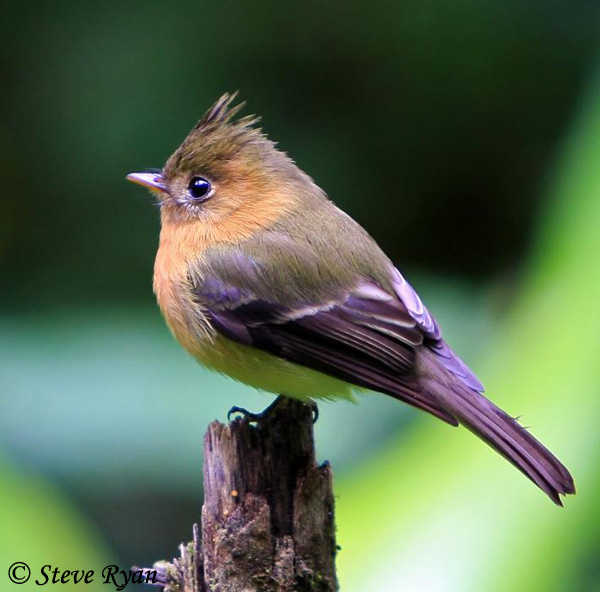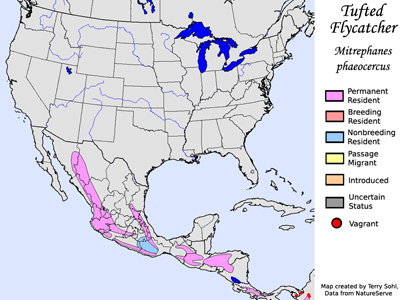| Length: 4.75 inches | Wingspan: 7.5 inches | Seasonality: Non-resident in South Dakota |
| ID Keys: Olive-green upperparts, dark wings and tail, orangish face and breast fading to more yellowish belly | ||
 The
Tufted Flycatcher is primarily a species of Mexico and Central America.
In the United States, they are known from a handful of sightings, with
multiple sightings in west Texas, in Big Bend National park, but also with
sightings in southern Arizona. With their rich coloring and the
obvious tuft, the Tufted Flycatcher is a rather easy to identify should it
be found in the United States.
The
Tufted Flycatcher is primarily a species of Mexico and Central America.
In the United States, they are known from a handful of sightings, with
multiple sightings in west Texas, in Big Bend National park, but also with
sightings in southern Arizona. With their rich coloring and the
obvious tuft, the Tufted Flycatcher is a rather easy to identify should it
be found in the United States.
Habitat: Found in forest areas, usually around forest clearings and forest edges.
Diet: Feeds on insects
Behavior: Forages by observing from a perch, flying out to capture insects in mid-air, or flying out and hovering briefly while gleaning insects from foliage.
Nesting: The nest of a Tufted Flycatcher is a shallow cup built of mosses, lichens, and other material. The female usually lays 2 eggs, and she alone incubates them. When the eggs hatch, both parents help tend to the young and feed them.
Song: Song of a Tufted Flycatcher is a very fast, high-pitched bip-bip-bip-dididiup-bip-bip-bibibiseeeer.
Migration: Considered a permanent resident throughout most of their range. Short-distance migrations do occur for some populations, particularly those found at high elevations during the summer.
Interactive eBird Map: Click here to access an interactive eBird map of Tufted Flycatcher sightings
Similar Species: Unique coloring in combination with the tufted appearance make the Tufted Flycatcher a rather distinctive bird compared to other small birds that might be encountered in Texas or Arizona (the two locations they've been seen in the United States).
Conservation Status: Populations are found over a wide geographic area, they are stable, and the species is common in parts of its range. The IUCN lists the Tufted Flycatcher as a species of "Least Concern".
Further Information: 1) BirdLife International - Tufted Flycatcher
2) Avian Web - Tufted Flycatcher
3) Wikipedia - Tufted Flycatcher
Photo Information: Photo taken by Steve Ryan - February 11th, 2010 - Costa Rica - Photo licensed under Creative Commons Attribution ShareAlike 2.0 Generic License.
| Click below for a higher-resolution map |
 |
| South Dakota Status: Non-resident in South Dakota |
Additional Tufted Flycatcher Photos (coming soon!!)
